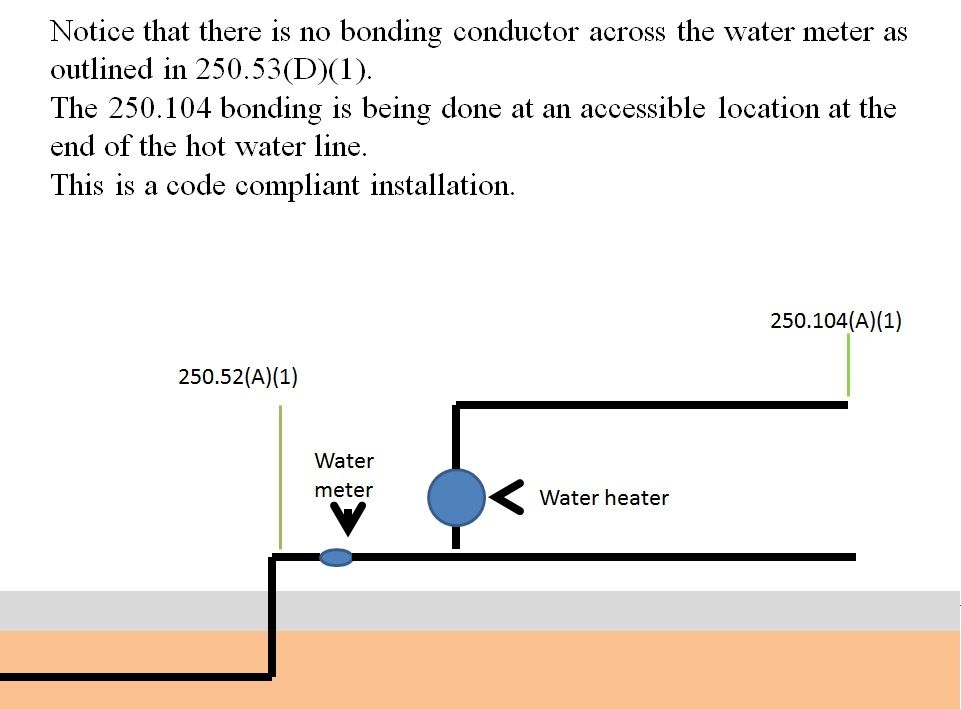So Mike just to clarify, are you saying or do you agree that:
1. in your drawing, if the water meter was non conductive, and if the 250.52 bond was connected on the right side of the water meter, a bonding jumper around it would be ok
If the 250.52(A)(1) bond was on the house side of the water meter then a bonding jumper to the electrode side of the meter would be required by 250.53(D)(1)
2. if the water heater and the water meter were nonconductive thru, then the piping system between them would need to be bonded back to one of the 4 acceptable places
Once the 250.52(A)(1) GEC in installed to the grounding electrode then the bonding required by 250.104(A)(1) has only one requirement and that is that the point where it hits the pipe be accessible. Yes to install the 250.104(A)(1) bond it could land anywhere on the pipe and nothing else would be required to be done at the water heater.
3. If the water heater and water meter were conductive, the 250.52 bond in you picture would also serve as the 250.104 bond
If the meter was conductive and the 250.52(A)(1) GEC was on the house side of the meter a bond would be required by 250.53(D)(1). There is no requirement in the NEC concerning the water heater
4. say in your picture the water heater were thru conductive but the water meter was not. do you agree it is then acceptable to keep your 250.52 bond as shown, eliminate the 250.104 as shown, and install a jumper across the water meter. now the water piping (to the right of the meter) is bonded (with the jumper across the water meter) to one of the grounding electrodes which is one of the 4 acceptable places to land the jumper?
No. the 250.104(A)(1) bond has four places it can land. Across a water heater is not mentioned anywhere in the NEC.
5. say the water heater is non conductive but the water meter is. Also say there is 10 feet of pipe between the meter and heater. Your 250.52 is installed as shown, you 250.104 is eliminated. you could not bond with a jumper around the water heater because that jumper is NOT landing on one of the four acceptable places. Even though there is no requirement that the bonding jumper be continuous, you propose that the ten feet of pipe cant act as a section of the bonding jumper bonding the interior piping to the grounding electrode (underground water pipe)?
The interior metal water piping can bond to one of the electrodes so yes it could bond across the water meter and that is all that is required. There is no requirement to make a water piping system electrically continuous. There is no requirement to bond across a water heater or a piece of non-metallic pipe found somewhere in the piping system
The proposal has been posted on this site so many time that it is beginning to get wore out.
5-236 Log #2432 NEC-P05
Final Action: Reject
(250.104(A)(1))
____________________________________________________________
Submitter: Robert P. McGann, City of Cambridge
Recommendation: Revise text to read as follows:
Metal water piping system(s) that is likely to be energized , installed in or attached to a building or structure shall be bonded.
Substantiation: With much expanded use of plastic water piping system(s) isolating section of metal piping systems. This type of installation leaves contractors and inspectors what is required to be bonded.
Panel Meeting Action: Reject
Panel Statement: The requirements of 250.104(A) apply to complete metallic water piping systems. Where there is no complete metallic water piping system, then the requirements of 250.104(B) would apply for those portions of isolated metal water piping system likely to become energized.
Number Eligible to Vote: 15
Ballot Results: Affirmative: 15

